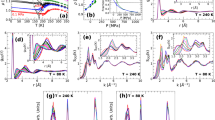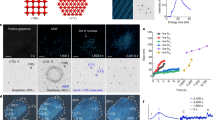Abstract
FOLDS are commonly observed features of naturally deformed rocks1 and glaciers2,3. Many different materials4 have been used to model naturally occurring fold patterns. The deformation experiment described here used ice as an analogue for quartz in quartz-rich rocks by deforming a sample with an initially planar layering or anisotropy. This deformation is compared with samples of unlayered isotropic polycrystalline ice (Fig. 1a). Ice is convenient to use in the laboratory because of its relative ease of deformation at readily controlled temperatures. When used to model the behaviour of quartz-rich rocks, ice is a realistic analogue because both ice and quartz have: (1) hexagonal crystal structures; (2) exhibit similar optical properties; (3) form polycrystalline aggregates; and (4) deform using common crystallographic slip planes, particularly the (0001) basal planes5,6. In our experiments, a sample of multilayered ice consisting of plates of fine-grained ice sandwiched between layers of coarser ice (Fig. 1c) was deformed in a plane strain apparatus. The c-axis orientations of the grains were initially random and therefore the composite sample resembled the structure of many naturally occurring quartzites7. The experimental technique described here makes it possible to explore the relationship between initial anisotropy on folding and fabric development.
This is a preview of subscription content, access via your institution
Access options
Subscribe to this journal
Receive 51 print issues and online access
$199.00 per year
only $3.90 per issue
Buy this article
- Purchase on Springer Link
- Instant access to full article PDF
Prices may be subject to local taxes which are calculated during checkout
Similar content being viewed by others
References
Weiss, L. E. The Minor Structures of Deformed Rocks (Springer, Berlin, 1972).
Hambrey, M. J. Tectonophysics 39, 397–416 (1977).
Hudleston, P. J. Geol. Soc. Am. Bull. 87, 1684–1692 (1976).
Johnson, A. M. Styles of Folding (Elsevier, Amsterdam, 1977).
Hobbs, P. V. Ice Physics (Clarendon, Oxford, 1974).
Christie, J. M., Griggs, D. T. & Carter, N. L. J. Geol. 74, 368–371 (1966).
Wilson, C. J. L. Tectonophysics 19, 39–81 (1973).
Kamb, B. Am. Geophys Union Monog. 16, 211–241 (1972).
Budd, W. F. & Matsuda, M. Low Temperature Sci. A32, 261–265 (1974).
Turner, F. J. & Weiss, L. E. Structural Analysis of Metamorphic Tectonites (McGraw-Hill, New York, 1963).
Tullis, J. A. Tectonophysics 39, 87–102 (1977).
Budd, W. F. Z. Gletscherk. Glazialgeol. 8, 65–105 (1972).
Lister, G. S., Paterson, M. S. & Hobbs, B. E. Tectonophysics 45, 107–158 (1978).
Lister, G. S. & Price, G. P. Tectonophysics 49, 37–78 (1978).
Author information
Authors and Affiliations
Rights and permissions
About this article
Cite this article
WILSON, C., RUSSELL-HEAD, D. Experimental folding in ice and the resultant c-axis fabrics. Nature 279, 49–51 (1979). https://doi.org/10.1038/279049a0
Received:
Accepted:
Issue Date:
DOI: https://doi.org/10.1038/279049a0
Comments
By submitting a comment you agree to abide by our Terms and Community Guidelines. If you find something abusive or that does not comply with our terms or guidelines please flag it as inappropriate.



